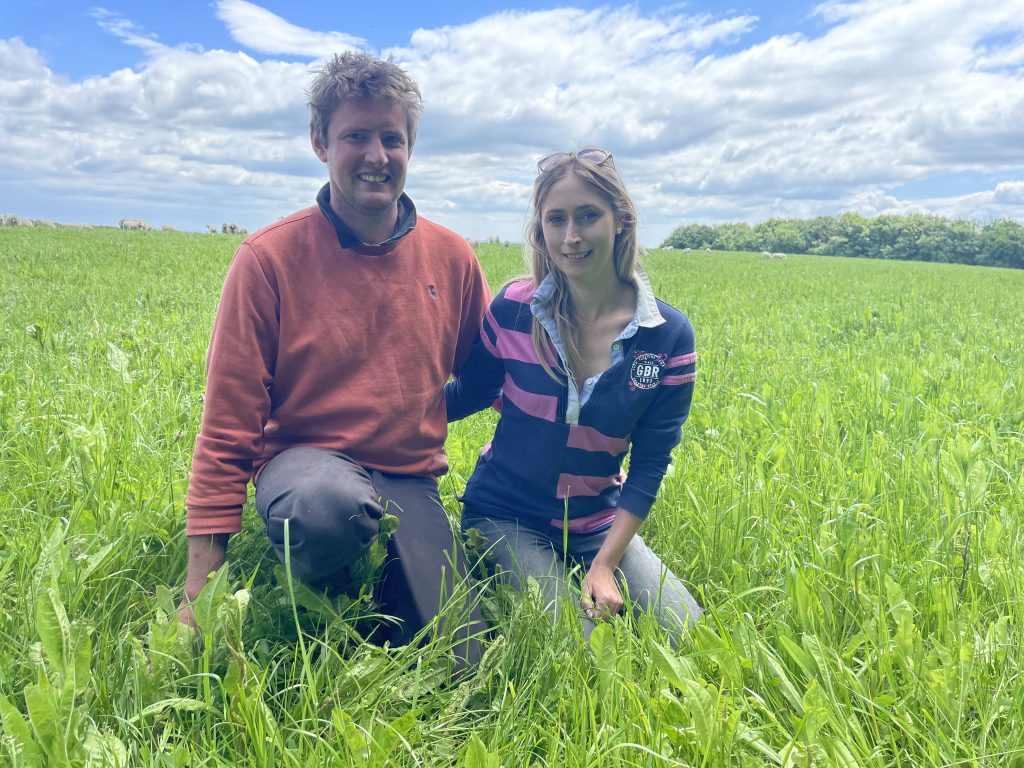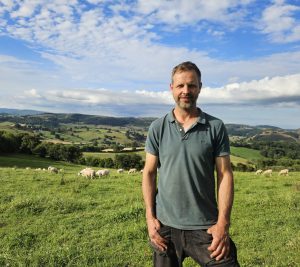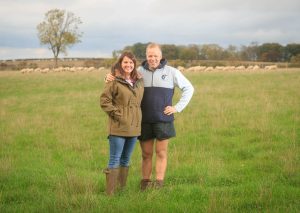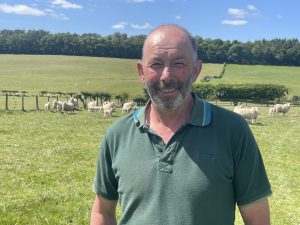with thanks to Sam and Samantha Edwards, Cerne Abbas, Dorset
Establishing a low input forage-based sheep enterprise was an obvious choice for new entrants, Sam and Samantha Edwards when they agreed a business partnership back in 2020. “We’d worked out high output grass reared lamb was the cheapest and only way to go, particularly since we had no capital to start out with. We wanted to push as hard as we could to achieve a 200% scan, however, we knew it wasn’t always going to be achievable until we became aware of grass bred and reared Highlanders, maternal genetics from Innovis,” he explains.
In 2022 the couple invested in 200 Highlander ewes to supplement their original start up flock of Poll Dorsets. “Last season the Highlander flock scanned 189% and reared 167% solely off grass. “We lamb outdoors in April with 84% complete within the first three weeks, intervention is minimal, and we soon found that the ewes make tremendous mothers, they have good udders with plenty of milk and don’t let their lambs run out of sight,” she says.
Lambs are reaching 43kg target from 13 weeks, after which to maintain cash flow we sell through the live ring throughout the season; 40% are away by 20 weeks
“In fact, less is definitely more,” she continues. “We drive around twice a day, three times in poorer weather – we’ve learned the ewes like to be left alone to get on lambing themselves; while ewe lambs disappear into a hedge and reappear with a lamb 48 hours later. Lambs are reaching 43kg target from 13 weeks, after which to maintain cash flow we sell through the live ring throughout the season; 40% are away by 20 weeks while this last season we stored a portion over the winter and capitalised on the strong market earlier this year. We keep tabs on lamb performance weighing fortnightly from eight weeks.”
Aware that the choice of damline would impact on the flock’s performance for the next decade, Sam says he was somewhat sceptical about Innovis genetics until he witnessed the Highlander successfully working on large units. “I realised the Highlander was scalable and it had the potential to fit in to any system, and that’s proved the case. We’ve noted our flock performs just as well on permanent pasture as it does on GS4 mixes which really suits us since we can’t guarantee good grazing 365. We body condition score ewes three times a year and find ewes maintain themselves in BCS 3.5 all year round,” he says adding: “These ewes perform, and they’ve got the looks too.”
Eager to continue flock expansion, the Edwards are retaining Highlander ewe lambs for replacement purposes while phasing out the Poll Dorsets which they say are ‘concentrate hungry’. With the opportunity to take on more land last year, they also agreed to become breeding partners for Innovis and took on 220 ewes and 130 shearling ewes, a split between the Abermax terminal sire and the wool shedding Aberglan.
“All these ewes being forage bred and reared perfectly fit our system. The Abermax scanned 172% and the Aberglans 181%, they settled into the same grazing system as the Highlanders, overwintering on cover crops from November until April when we introduce them to the lambing paddocks and set stock at up to five ewes per acre. They lamb outdoors with minimal management requirements; once complete they move on in mobs of 150 to 200 ewes plus lambs to rotational grazing.
Top tips for new entrants
- Make it work as a business
- Think low input, high output strategies
- Don’t get bogged down in the idyllic lifestyle trap
- Make yourself known locally – show that you dedicated and a hard worker
- Opportunities don’t always come at the right time, but make the most of them if you can
We just live and breathe farming. I started from scratch with just one acre and a handful of ewes. Seven years on and despite being ambitious I never dreamt we’d be where we are today,” Sam says. “Meeting Samantha was the catalyst for really getting focused and establishing our business partnership in 2020, and in the last 12 months recorded profit for the first time.”
Both Sam and Samantha are new entrants to the sector. “I was studying for A levels, woke up one morning and decided I wanted to go farming,” says Sam reflecting on his damascene experience. “I quit school, got a place at Kingston Maurward College and graduated in 2011 with a National Diploma in Agriculture triple distinction and awarded student of the year,” he explains. While Sam came from a retail background, Samantha’s father was an agricultural engineer. “I’d spent 10 years as a children’s nanny and had no farm experience until I met Sam over five years ago,” she says.
“Our objective was to farm in our own right, potentially renting a County Council smallholding. For the long term we hankered for land and a farmhouse, but we’ve come to accept it’s just not going to happen and instead we have revised our plans. We are now graziers, we are building a business renting land, all on a grazing licence and within a 10-mile radius of Cerne Abbas village.
“We are very lucky to live in an area where suitable grazing is coming available. We’ve built a relationship with local farmers aware we are on the lookout for more land, and we never turn any down because we never know when we may lose some. However, those signing up to join the SFI have accelerated opportunities in the last couple of years and they all see the benefits,” he explains.
“We work with these farmers to develop our own individual arrangements, for example our 1,000 acres of winter grazing with the three different landowners involves us buying the cover crop seed, in return for the grazing – no money changes hands, nor do we receive any SFI payments.
“Overall fixed costs have been minimised to a mobile handling unit, 11 miles of electric fencing wire, two trucks, a UTV and trailer plus two dogs, and the start-up Highlander flock. We accept we have a substantial diesel bill, however variable costs are minimal. Without a six-figure turnover, our biggest challenge has been sourcing finance from banks, however it’s thanks to our families who have stepped in and helped us expand.”
Whilst building the business Sam supplemented income with a contracting business including working as a vet tech for the local animal practice until last year. “Working off farm just wasn’t sustainable along with managing our own sheep – I was spending 14 hours a day, seven days a week. Nowadays for example, from November through to mid-March I’ve an eight-hour day moving fencing – 50 to 70 acres fields are split in to 10-acre blocks grazed by mobs of 150 ewes rotated every seven days.”
To the future and the couple say: “We’re determined to make a proper success of the business which includes taking a proper salary while attempting to achieve a work life balance. We’re now looking to take on a part time person to help out so we’ve the opportunity to spend more quality time with George, our two-and-a-half-year-old and in the long term buy some of our own land as an investment for him.”



